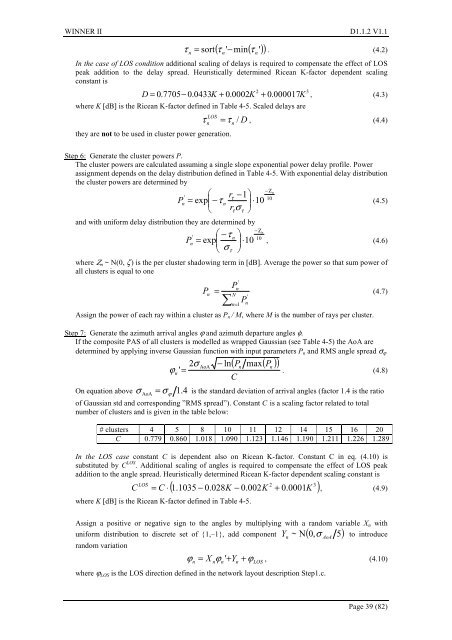"WINNER II Channel Models", ver 1.1, Sept
"WINNER II Channel Models", ver 1.1, Sept
"WINNER II Channel Models", ver 1.1, Sept
Create successful ePaper yourself
Turn your PDF publications into a flip-book with our unique Google optimized e-Paper software.
<strong>WINNER</strong> <strong>II</strong> D<strong>1.1</strong>.2 V<strong>1.1</strong><br />
( τ ' − min( τ '))<br />
τ = sort<br />
. (4.2)<br />
n<br />
n<br />
In the case of LOS condition additional scaling of delays is required to compensate the effect of LOS<br />
peak addition to the delay spread. Heuristically determined Ricean K-factor dependent scaling<br />
constant is<br />
D +<br />
n<br />
2<br />
3<br />
= 0.7705−<br />
0.0433K<br />
+ 0.0002K<br />
0.000017K<br />
, (4.3)<br />
where K [dB] is the Ricean K-factor defined in Table 4-5. Scaled delays are<br />
LOS<br />
τ = τ D , (4.4)<br />
n n<br />
/<br />
they are not to be used in cluster power generation.<br />
Step 6: Generate the cluster powers P.<br />
The cluster powers are calculated assuming a single slope exponential power delay profile. Power<br />
assignment depends on the delay distribution defined in Table 4-5. With exponential delay distribution<br />
the cluster powers are determined by<br />
'<br />
⎛<br />
Pn<br />
= exp<br />
⎜−<br />
⎝<br />
n<br />
r 1⎞<br />
τ<br />
−<br />
10<br />
r<br />
⎟ ⋅<br />
τστ<br />
⎠<br />
and with uniform delay distribution they are determined by<br />
'<br />
P n<br />
−Ζ<br />
10<br />
n<br />
τ (4.5)<br />
⎛ −τ<br />
⎞<br />
n<br />
= exp<br />
⎜<br />
⎟ ⋅ 10<br />
⎝ σ τ ⎠<br />
−Ζ<br />
10<br />
n<br />
, (4.6)<br />
where Ζ n ~ N(0, ζ ) is the per cluster shadowing term in [dB]. A<strong>ver</strong>age the power so that sum power of<br />
all clusters is equal to one<br />
P<br />
'<br />
n<br />
n<br />
=<br />
N<br />
∑ n = 1<br />
P<br />
Assign the power of each ray within a cluster as P n / M, where M is the number of rays per cluster.<br />
Step 7: Generate the azimuth arrival angles ϕ and azimuth departure angles φ.<br />
If the composite PAS of all clusters is modelled as wrapped Gaussian (see Table 4-5) the AoA are<br />
determined by applying in<strong>ver</strong>se Gaussian function with input parameters P n and RMS angle spread σ ϕ<br />
On equation above 1. 4<br />
AoA<br />
2 ln<br />
' = σ AoA<br />
−<br />
C<br />
P<br />
'<br />
n<br />
( P max( P ))<br />
(4.7)<br />
n<br />
n<br />
ϕ<br />
n<br />
. (4.8)<br />
σ = σ is the standard deviation of arrival angles (factor 1.4 is the ratio<br />
ϕ<br />
of Gaussian std and corresponding ”RMS spread”). Constant C is a scaling factor related to total<br />
number of clusters and is given in the table below:<br />
# clusters 4 5 8 10 11 12 14 15 16 20<br />
C 0.779 0.860 1.018 1.090 <strong>1.1</strong>23 <strong>1.1</strong>46 <strong>1.1</strong>90 1.211 1.226 1.289<br />
In the LOS case constant C is dependent also on Ricean K-factor. Constant C in eq. (4.10) is<br />
substituted by C LOS . Additional scaling of angles is required to compensate the effect of LOS peak<br />
addition to the angle spread. Heuristically determined Ricean K-factor dependent scaling constant is<br />
2<br />
3<br />
( <strong>1.1</strong>035<br />
− 0.028K<br />
− 0.002K<br />
0.0001K<br />
)<br />
C LOS C ⋅<br />
+<br />
= , (4.9)<br />
where K [dB] is the Ricean K-factor defined in Table 4-5.<br />
Assign a positive or negative sign to the angles by multiplying with a random variable X n with<br />
uniform distribution to discrete set of {1,–1}, add component N( 0, 5)<br />
random variation<br />
n<br />
n<br />
n<br />
n<br />
LOS<br />
n<br />
~<br />
AoA<br />
Y σ to introduce<br />
ϕ = X ϕ ' + Y + ϕ , (4.10)<br />
where ϕ LOS is the LOS direction defined in the network layout description Step1.c.<br />
Page 39 (82)
















